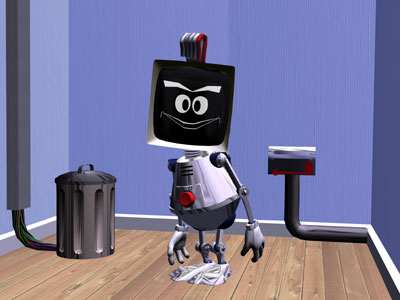 Nowhere does humanity strive more to imitate robotic perfection as in plays, concerts and dance performances. In each of these forms of creative expression we have a "programmer", respectively a playwright, composer or choreographer. Fancy names, but they are really nothing more than programmers. These programmers write out a set of instructions which are to completely control what will take place in front of the audience. But it never works! Inevitably the actors forget their lines and make up new ones, the musicians begin jamming spontaneously, and the dancers sweat under the strain of so many synchronized motions. None of this would ever happen to robots!
Nowhere does humanity strive more to imitate robotic perfection as in plays, concerts and dance performances. In each of these forms of creative expression we have a "programmer", respectively a playwright, composer or choreographer. Fancy names, but they are really nothing more than programmers. These programmers write out a set of instructions which are to completely control what will take place in front of the audience. But it never works! Inevitably the actors forget their lines and make up new ones, the musicians begin jamming spontaneously, and the dancers sweat under the strain of so many synchronized motions. None of this would ever happen to robots!Having observed the imperfect implementations of various human productions, I have reflected upon my own ideas to innovate the performing arts. The result of my reflections are these steps which assure ideal performances of any piece.
1) Copy and paste instructions into robot minds
2) Wind up the robots
3) Push start button
4) Watch production
The list is a simplified description of the procedure. Of course the robotic performances would contain more complex subtleties. For example, we would set a maximum performance time to guide the length of the performance. If it is a very long time, the robots would incorporate liberal usage of dramatic and comic pauses, all mathematically derived to fill the available space. For a short production, robots would churn out syllables and actions at a rapid rhythm and pace.
Of course every human production is flawed because the audience (also humans) does not have instructions on how to react to the performance. Some laugh, some cough, some fall asleep. Therefore, the next step towards perfection is to exchange the human audience for an audience of pre-programmed robotic spectators who are painstakingly synchronized with the stage performance. Applause, laughter and electrical shocks would balance harmonically with actions occurring on stage.
When a human production is over, the uncoordinated activity advances to new heights, with critics all writing a completely different opinion of what they saw. This introduces added confusion, as no one now knows what to make of the show. This lack of uniformity would never occur with mechanical beings holding the pens. Identical reviews, down to the letter and opinion, that is what today's performing arts require, and operating systems to execute the performance instructions precisely and identically. Each time.
----
Many thanks to Angelina who suggested this monograph with her comment at my facebook page! Your suggestion could be the next article!

No comments:
Post a Comment